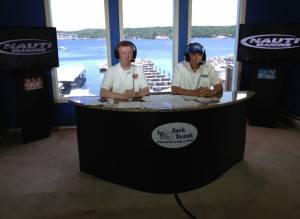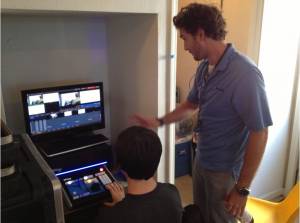Mixing EFP, ENG and powerboats
Many TV stations produce and broadcast a long-form live non-news live event once a year or so. The event may be an annual parade, live coverage of a 4thof July or national sports championship celebration, or a regular local program occasionally produced on location. Typically, such shows are electronic field production (EFP) events, produced primarily with electronic news gathering (ENG) gear.
The difference between EFP and ENG styles is that most live ENG news events are shot with a single camera and switched on a production switcher back at the station’s studio, where graphics, b-roll, replays and commercials are inserted. Most live EFP events use multiple cameras switched on-location, with graphics, b-roll and replays inserted on-location, usually inside a production vehicle or trailer. Typically, such events are relayed to a station via microwave or satellite. More recently, some are backhauled to the studio with a bonded cellular platform.
Delay? What delay?
At most EFP-style productions, cameras usually are connected to the switcher by microwave, copper or fiber optics, with negligible delay. The additive delay of digital production gear and satellite or bonded cellular backhauls usually isn’t a problem as long as the on-mic talent hears a mix-minus feed in his or her IFB or headset.
What may happen when you mix certain new EFP and ENG styles can impact the basic rules of television production. I recently experienced this phenomenon while directing and switching a two-day Offshore Speed Series (OSS) powerboat race in HDTV at the Lake of the Ozarks, MO. Our plan was to make our limited-budget teleproduction match the beauty of the big-budget boats on the racecourse.
Aural race coverage was broadcast on KRMS Radio, Osage Beach, MO, and the HDTV feed was simulcast on KRBK-TV FOX49 in Springfield, MO. For broadcast telev

ision, we used a Dejero platform to backhaul the HD-SDI and analog audio outputs of our temporary studio to KRBK’s master control, approximately 90mi away. Half the commercials were inserted on-location; the other half were inserted locally at the radio and TV broadcast studios. We dialed in a 10-second delay on the backhaul to KRBK, so the station's master control operator could accurately countdown to local commercial breaks.
The professional video industry's #1 source for news, trends and product and tech information. Sign up below.
I’ve directed and switched several powerboat races, but they were all one boat at a time, with each boat individually competing for top speed across a finish line that was outfitted with special radar guns. Single boat races were relatively simple to direct and switch. Cameras tracked a lone boat speeding down the course, followed by a couple of minutes of replays, stats and color stories while the next boat staged for its run. The action was easy to follow, and camera output delays weren’t an issue if all cameras were delayed equally.
The OSS race was more like a NASCAR event. There were multiple world-class powerboats on an oval racecourse simultaneously at speeds up to approximately 175 MPH, with some lapping others. We had three cameras set up on condo balconies along the 2.5mi course, each connected to the control room by Wi-Fi using Dejero bonded cellular platforms. We chose to use the Wi-Fi connection in lieu of cellular because there were only two cell towers in the area, and spectators numbering in the tens of thousands were expected on race days. We had line-of sight from all camera positions, and a Wi-Fi repeater alleviated distance concerns.
Paging Mr. Murphy
When race day arrived, the Wi-Fi signal from one condo location was less stable than it was during setup, as it was unpredictably blocked at the last moment by a neighbor’s rearranged deck furniture. Fortunately, the owner of the condo balcony the camera was on had a local cable system router. Unfortunately, we had to dial in a longer delay at each camera position to match the delay of the slower upload speed of the cable modem.
As the action began, it became apparent in the control room and to camera operators that we weren’t using microwaves or hard connections. Not only did we not have tally lights, but the output I was seeing from the cameras lagged several seconds behind what the camera operators were doing. Directing individual cameras to pan, zoom, get a different shot, or even telling operators when they were hot or clear wasn’t working. This left the three on-course camera operators on their own to watch for action such as spin-outs or worse, and self-direct their shots. The best I could do was trust my camera

operators, take the best shots available and hope not to catch a swish zoom. The camera operators were on the ball, and no one at home was the wiser.
The fourth channel of the bonded servers was used for an iPhone. It transmitted live beauty shots with natural sound away from the racecourse in the “vendor village” area. We had planned to use it in a helicopter but ran out of available operators with the time necessary to go off-site to take the ride.
Except for a couple of rare if-you-blinked-you-missed-it hiccups, the quality of the HD signals from each camera and the backhaul to Springfield, MO, looked like hardwire. We produced and backhauled the three-hour daily, two-day event in 1080i, although KRBK FOX49 broadcast it in 720p. Conversion from 1080i to 720p was performed within the dedicated server on-site at KRBK’s studio.
Instant replays
There are several ways to produce instant replays, and those systems designed for sports replays are always best for the task. NewTek provided us with a brand new 3Play 4800 to record the isolated outputs of each of the three racecourse cameras on dedicated hard drives. The system, controller and screen layout was so intuitive and simple; NewTek sales engineer James Miller trained a local 18-year old high school student how to master the device in less than 30 minutes. The output could be switched at the 3Play, thus requiring only one production switcher input.
Not only was the device handy for replays, but also it proved to be a powerful tool to produce a daily highlight reel without doing more than drag-and-drop. Th

e race event lasted two days, and there was ample room on the hard drives to record continuous isolated HD feeds without looping. On the second day, wouldn’t you know, it appeared the races might be delayed by rain. Before I thought to ask, the replay operator had already prepared a highlight reel from the previous day, complete with special-effect transitions, ready to air. The rain delay was short, and viewers at home were treated to an exciting highlight reel that looked like we had planned it and spent a couple of hours preparing it. We knew better, and smiled among ourselves.
Later that afternoon, one of the leading powerboats spun out spectacularly. Nobody was hurt, but one camera caught the action front and center, and our student operator was replaying it back and forth in slow motion immediately before I asked for it. Several other boats developed mechanical problems as the race went on, and we showed immediate replays of each, much to the delight of our announcers and viewers.
Lessons learned
We proved it is much less expensive to use a temporary bonded cellular platform than a mobile satellite uplink for long-form live field productions, and it’s just as reliable. Uncontrollable last-minute changes at one camera location also proved that Murphy’s law is always lurking, even at vacation venues.
Many on the production team learned that a 42in consumer flat-screen multiviewer is not a studio reference monitor. Those who had not previously worked w

ith a multiviewer had to get used to the electronic labels cutting across the bottom of each screen. Some had more difficulty making this adjustment than others. However, the benefits of the multiviewer far outweighed the mind adjustments, as the monitors were bright, complete and easy to setup, and the footprint was small.
Our broadcast coverage of the world-class event was a first-class production everyone was proud of. It was also our own personal transition to digital, because all previous Lake of the Ozarks powerboat races were produced using analog SD gear. It’s always rewarding when a plan comes together, particularly when it looks like you planned it as well as it turned out.
